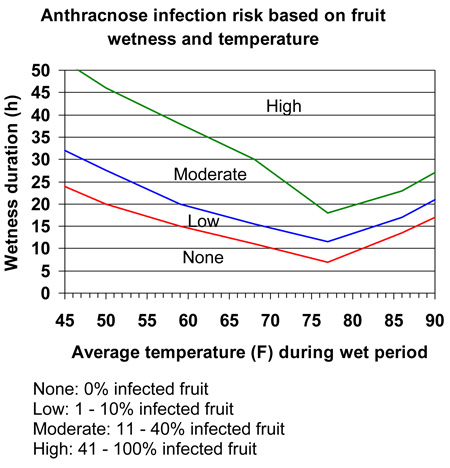Anthracnose fruit rot prediction model
Editor’s note: This article is from the archives of the MSU Crop Advisory Team Alerts. Check the label of any pesticide referenced to ensure your use is included.
A disease prediction model for anthracnose fruit rot infection has been developed and will be available soon on the Enviro-weather website. The model is based on wetness and temperature requirements for fruit infection. Wetting of fruit can be caused by rain or dew. The model does not take into account overhead irrigation, which can increase fruit infection risk. The model is currently under field validation and should be considered as providing an indication of relative infection risk based on weather data collected by Enviro-weather’s stations.
Weather stations are present throughout much of Michigan’s blueberry-growing area, including Grand Junction, South Haven, Fennville, West Olive, Waterville and Benton Harbor. Environmental conditions are recorded every five minutes and are updated on the website every 30 minutes. Weather data can be accessed online by clicking on the appropriate weather station location through the Enviro-weather. If your farm is located between weather stations, it is advisable to look at the weather data recorded by the two nearest weather stations. Always remember that weather conditions are variable. Therefore local observations on your own farm are the most accurate, particularly where rainfall and leaf wetness are concerned.
How to use the anthracnose prediction model
The model can be used from bloom until harvest. Since the model will use recent weather data, it will indicate if an infection period has occurred after a wetting event. There is no risk of infection if the fruit remains dry. An infection period is indicated when minimum wetness and temperature conditions for infection have been met. If an infection period has occurred and the plants were not already protected by a fungicide, a systemic fungicide (Cabrio, Abound or Pristine) should be applied within 24 hours (at most 48 hours) to stop the infection in its tracks, particularly if the infection risk is moderate or high. Remember that fruit infection is latent (not visible) until fruit starts to ripen, and that many infections will not manifest themselves before harvest or at all. However, the higher the percentage of latent fruit infection, the greater the chance that fruit will rot after harvest.
On ripe fruit, the infection advances more rapidly than on green fruit and is already well-established after 24 hours, so if a curative spray cannot be applied immediately following the infection period, preventative fungicide sprays should be used. Once a fungicide has been applied, consider the plants covered for 10-14 days before you need to consult the model again to decide on your next spray.
You can also apply a protectant or systemic fungicide (Captan, Ziram, Omega, Switch, Pristine, Abound or Cabrio) before a major rain event based on the local weather forecast. This is a good idea if several days of rain or windy conditions are predicted, such that it will be difficult to get into the field to apply a spray within the limited time frame after an infection period has occurred. In addition, it is important to alternate different chemistries because using strobilurins repeatedly can increase the risk of fungicide resistance development.



 Print
Print Email
Email






